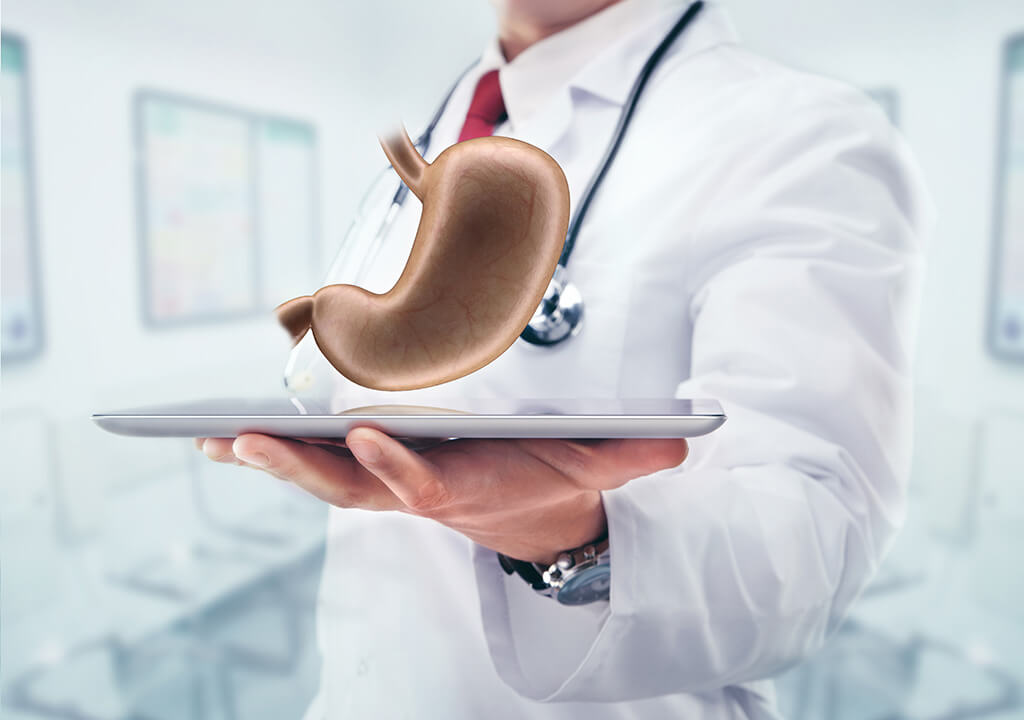Due to changes in lifestyle, dietary habits, and physical activity level GERD affects more and more people in the contemporary world. For example, more than 20 million people in the USA currently suffer from this disease. GERD treatment options have evolved from symptomatic drug treatment to comprehensive target surgical interventions during the last few decades.
One of the most promising techniques, which has already helped millions of patients defeat GERD, is LINX Reflux Management System implantation. LINX restores the natural passage of food along the gastrointestinal tract and directly prevents acid reflux. This minimally invasive technique has shown effectiveness in controlling GERD symptoms and improving the quality of patients` lives.
What does the diagnosis GERD mean?
Abbreviation GERD stands for gastroesophageal reflux disease; another name of the condition is acid reflux. “Reflux” means moving backwards or returning. So, as it is obvious from the medical term itself, GERD implies an abnormal movement of food and liquid between the esophagus and stomach. To be more precise, GERD is a pathologic returning of the stomach contents upwards – to the esophagus. In healthy people, such a situation is prevented by correct work of the lower esophageal sphincter (LES). LES is a bundle of muscles at the lower end of the esophagus, where it enters the stomach. LES provides one-way movement of food and liquid, preventing stomach acid, duodenal bile, digestive enzymes, and undigested substances from returning to the esophagus.
This sphincter becomes weak and doesn`t perform its natural function in people with GERD. When we look at the disease superficially, reflux may seem not to be a problem. Indeed, if this food has passed through the esophagus once, then why should it cause harm when passing twice? The problem is in the acidic environment of the stomach and the additional presence of digestive enzymes. Food with acidic stomach juices and bile injures the unprotected and sensitive inner lining of the esophagus.
In GERD, direct damage and subsequent inflammation of the esophagus tissues is a constant process, as GERD is a chronic condition. Permanent damage leads to arising of various clinical symptoms. Sometimes it can be hard to reveal the actual cause of complaints, as GERD influence is not restricted to gastrointestinal manifestations.
The most widespread signs of the disease include the following:
- Heartburn. This is a burning feeling in the upper abdomen or the chest. Sometimes it can spread to the neck or angle of the jaw and even be mixed with heart attack pain.
- Regurgitation. This is the sensation of stomach contents in the esophagus or even feeling acid taste in the oral cavity. Both heartburn and regurgitation are the most typical causes of sleep disturbances in patients with GERD.
- Persistent cough. Irritation of mucous membrane and permanent inflammation result in dry cough; in this case, the need to clear the throat is not relieved by antitussives. Also, reflux may result in voice changes (hoarseness) or the feeling of a “lump” in the throat.
- Stomatological problems and bad breath. When moving higher to the oral cavity, acidic stomach contents may harm gums and tooth enamel. In addition, normal microscopic flora (useful bacteria) of the oral cavity die in the acidic environment, and bad breath appears.
GERD, especially in the case of severe reflux, may worsen the course of concomitant diseases, namely, bronchial asthma, ear infections, and chronic sinusitis. It should be emphasized that GERD is also considered to be a main cause of the pre-cancerous condition – Barrett`s esophagus.
GERD treatment options
First of all, you should understand that reflux is a disease, not a simple and transitory reaction to inappropriate food. Like all diseases, GERD requires individual treatment, adjusted to the patient's clinical situation and general state.
In general, GERD treatment pursues two main aims:
- Lowering the amount of acid in the stomach and thus reducing the damage of the esophagus in case reflux has happened, and decreasing volume of reflux or, if possible, avoiding it at all.
- Sometimes lifestyle modifications and dietary changes are enough for the alleviation of GERD symptoms.
Recommendations in this field usually include the following:
- Decreasing the size of portions per meal. An excessive amount of food creates high pressure in the stomach, and weak LES fails to prevent reflux. Reducing the amount of food, at least per main meal, gives your stomach a good chance to digest it properly and timely pass it to the intestine.
- Having a last meal no less than 2-3 hours before going to bed. Lying in bed changes pressure in the stomach and increases the chance of having reflux. It is better to wait until the food leaves the stomach or, at least, elevate the head of the bed. Sleeping in different positions may also be beneficial.
- Avoiding products that stimulate acid production. We are talking about alcohol, fatty food, fried products, spicy food, coffee and black tea, citrus fruits, and juices.
- Losing weight in overweight people. Excessive body mass creates excessive pressure in the abdomen and thus causes reflux.
- Smoking cessation. Tobacco products cause transient LES relaxations and, naturally, aggravate the course of the disease.
In case these measures don`t improve the state of the patient significantly, doctors proceed to the next stage – medicinal treatment. The most widespread among GERD patients group of drugs is antacids. These non-prescription drugs are often seen in advertisements, promising easy and effective relief. Indeed, they neutralize the acid in the stomach and stop heartburn. The problem is antacids provide only temporary relief, as their action is reversible and they don`t solve the problem itself. An additional measure, which improves the situation, is foaming agents’ usage. They create a foaming barrier on the stomach's inner lining, directly protecting it from an acidic environment. Antacids and foaming agents seem to be reasonable solution for GERD patients. Still, we should consider their side effects in long-term use: diarrhea, calcium level disturbances, and increasing serum magnesium level.
A more serious treatment option is medicamental inhibition of acid secretion. Two groups of drugs are administered for this purpose: H2 blockers (like famotidine and ranitidine) and proton pump inhibitors (like omeprazole and pantoprazole). Using drugs may seem to be the most simple solution, as it is easy, may be performed by a patient independently, and doesn`t require any surgical intervention. Nevertheless, such treatment addresses only symptoms, not the cause of the disease – weak LES. In addition, GERD requires lifelong treatment, so buying drugs creates a significant financial burden.
The only radical treatment option, which corrects the origin of the disease, is surgical intervention. It is administered in case of severe reflux, influencing quality of life, poor response to drugs, and threatening general state on the background of the disease. The first surgical intervention performed for GERD treatment was Nissen fundoplication. This is an open or laparoscopic procedure pointed at reinforcing LES work by partial stomach reconstruction.
More up-to-date endoscopic procedures include:
- Fixing of LES, e.g., using electrodes to promote scarring and narrowing of LES, and
- LINX Reflux Management System implantation.
LINX implantation is the latest technique that doesn`t require stomach reconstruction or trauma and significantly improves the natural function of LES, addressing the pathologic background of GERD.
What is LINX?
The LINX Reflux Management System implantation is a laparoscopic, fundic-sparing procedure, which helps fight against acid reflux and indicated for patients with drug resistance, serious side effects of medicinal treatment, bad quality of life, and desire to stop lifelong drugs intake. LINX itself is a quarter-dollar-sized device. It is a small flexible band of interlinked titanium beads with permanent magnetic cores, which are connected with the help of independent titanium wires, so they finally form an annular shape. Creator of LINX, Torax Medical, Inc., used Magnetic Sphincter Augmentation technology platform for the development of the device. This technology uses attraction forces between the beads to improve and augment the existing LES barrier function.
It is quite natural that pressure in the stomach increases after the meal due to the volume of food. LINX placement helps LES resist high pressure in the stomach after food intake, so it stays closed and acid reflux is prevented. To ensure normal food and liquid passage, the process of swallowing temporarily breaks the magnetic bond of LINX titanium beads, which slide away from each other on the independent titanium wires. Thus lower part of the esophagus becomes wider, allowing food and liquid to come into the stomach. Right after swallowing, magnetic attraction is restored and LES is successfully closed naturally. Totally imitating the function of LES, LINX allows vomiting, if necessary (in poisoning, for example).
Unlike other surgical interventions, LINX Reflux Management System implantation doesn`t alter stomach function or anatomical structure, as it is placed around the esophagus in LES projection. Due to the high quality of the material (titanium) and personal adjustment of the device to the size of the patient`s esophagus LINX placement implies lifelong use of the device with sufficient control of acid reflux and absence of clinical symptoms. As the technique is innovative, we are not able to talk about remote results of the treatment, but 1 and 2-year follow-up show favorable results. In addition, titanium structure of LINX creates no restrictions regarding MRI (up to 0.75 and 1.5 Tesla depending on the model) and passing airport security (this implantable device will not affect detectors).
LINX completely restores the barrier function of weak or altered LED muscles and provides stable long-term control of acid reflux symptoms. As it was shown by preliminary results of CALIBER Study (Randomized Controlled Investigation of LINX Versus Double-Dose Proton Pump Inhibitor Therapy for Reflux Disease) in May 2017, LINX is more effective than omeprazole (mentioned above widely used anti-reflux drug) at reducing symptoms and improving quality of life in patients with GERD. This also confirms the importance of direct reflux control, as simple lowering acid levels in the stomach is not enough.
Proceeding to the surgery: how will it happen?
Treating GERD with LINX Reflux Management System implantation is a relatively new technique, but it has already been approved in a few countries (e.g. USA, England, Germany). Some insurance companies also cover this treatment variant, so you should check this option with your insurance company first. For example, Health Care Service Corporation (HCSC), which takes 4th place among the commercial health insurers in the USA, and its affiliates of Blue Cross Blue Shield has provided a medical coverage policy for the LINX implantation since April 2016. Another important step before implanting LINX Reflux Management System is the assessment of cautions and contraindications.
The surgeon will take a close look at the following aspects:
- Age under 21 years old. LINX is indicated only for people with a well developed gastrointestinal system. An underdeveloped esophagus is not suitable for the LINX placement. That is why the procedure is not indicated for the treatment of children and young adults.
- Allergy to titanium, nickel, stainless steel, and ferrous materials. These conditions are rare but should be excluded, as LINX may cause severe allergy in such patients. It should be noted that nickel is a part of the sizing tool, which is used during the surgery, not a component of the device itself. Thus nickel intolerance is not a strict contraindication.
- Esophageal or gastric cancer. The medical use of LINX in cancer patients hasn`t been investigated in a sufficient number of clinical investigations and can`t be recommended with confidence. Such patients may benefit more from other treatment options.
The device is implanted with the help of a minimally invasive laparoscopic procedure. This is a decent alternative option for more traumatic and anatomically disruptive Nissen fundoplication – the usual anti-reflux surgical intervention.
The main stages of the intervention are the following:
- Providing laparoscopic approach under general anesthesia
- Precision sizing tool placement. Precision sizing tool is a part of LINX kit that determines the individual appropriate LINX size. LINX is available in different sizes to correspond to the esophagus size of each patient
- LINX Reflux Management System implantation. LINX is placed around the esophagus, namely around LES. Ends of the device are aligned and carefully joined to ensure secure closure.
- If a hiatal hernia is revealed during the procedure, it should be repaired during the same intervention.
- The surgery comes to an end, skin incisions are closed with the help of sutures. LINX is created for long term use, but removal or replacement of the system may be provided at any time, if necessary
As LINX Reflux Management System implantation doesn`t imply anatomic alteration of the stomach, patients may go home the day after the intervention. There is no need to be on a special diet afterwards. Over time, LINX becomes covered with the mucosa of the esophagus external part. This is the final part of the healing process. One more useful option for people with LINX is registering their device with the Medical Alert Foundation (available for patients from the USA) – in case they need MRI with strength over 1.5 Tesla in the future, LINX will be removed in the proper time.
Why is LINX implantation worth choosing?
Most people try to postpone surgical treatment as long as possible. This is natural, especially for people who have never undergone invasive treatment. We should take into consideration all pros and cons of the intervention. The usual arguments of patients who hesitate about treatment with LINX Reflux Management System are listed below.
The first sounds like: “It is not that serious. I`m strong, and I will tolerate it without treatment.”, which is underestimating the severity of the condition. At first sight, reflux may seem no more than an unpleasant feeling. Some people prefer suffering from pain to having surgery.
Nevertheless, LINX implantation allows to control symptoms of acid reflux and, which is more important, to prevent severe complications of GERD:
- Esophageal bleedings. Acidic content damages blood vessels of the esophagus, causing intensive and life-threatening bleedings.
- Esophageal ulcers. Permanent injury gives the mucous membrane of the esophagus little chance to restore structure and function. Chronic ulcers arise, making the course of the disease more severe.
- Narrowing (stricture) of the esophagus on the background of chronic inflammation. The constant inflammatory process stimulates excessive formation of the connective tissue. This finally leads to esophagus narrowing and difficulties with swallowing.
- Barrett`s esophagus. Changes of mucous membrane, specific for this condition, are considered to be pre-cancerous ones. Controlling reflux is an obligatory measure of cancer prevention in this case.
The second argument sounds like this: “Why should it be the surgery? Taking pills is quite enough!”. This position also seems reasonable unless we take a look at the following facts:
- Pills don`t address the cause of reflux, they just mask symptoms. The problem will arise again and again
- In some patients, medicinal treatment doesn`t provide full relief. Symptoms may become milder but persist
- GERD requires lifelong treatment. Taking pills every day may become tiring and bring financial problems
- GERD medications have specific side effects, including problems with defecation and disturbed calcium exchange
The third one sounds like: “I don`t want to have surgery. It will cause more problems than GERD does at the moment.” Beyond all doubt, each surgery has certain risks and limitations, especially implantation procedures.
Despite that, peculiarities of LINX Reflux Management System implantation include:
- Minimally invasive surgery
- No need to stay at the hospital more than a day
- No need for a specific diet, additional medications, etc.
- Minimal restrictions regarding MRI (strength under 1.5 Tesla is possible)
- Complete restoration of LES physiological function, no need in rehabilitation
One more advantage that should be noted – LINX starts working immediately after the implantation, so you will feel positive changes from day one after the surgery. LINX improves the quality of life significantly, avoiding all previous restrictions in daily activity and sport.
Where can LINX implantation be performed?
LINX Reflux Management System implantation requires specific skills and should be performed by the surgeon:
- With appropriate experience in laparoscopic anti-reflux procedures
- Who has attended product-specific training
In addition, the hospital must be equipped properly to meet the technical requirements of this surgical procedure. Only limited number of centers in the USA, Great Britain, Germany, Austria, and Switzerland are certified for performing such interventions. If you are not a citizen of the abovementioned countries, you still have a chance to apply for treatment as an international patient. The possible problem ,in this case, consists in waiting in a long queue of international patients, as a higher priority in the treatment list is given to citizens and patients with insurance. Another tricky moment is the arrangement of preoperative examination and handling all organizational questions during the trip.
The most appropriate option for arranging treatment abroad is using the help of the company Booking Health. Booking Health is a medical tourism company that annually helps hundreds of patients with GERD with treatment abroad.
Booking Health offers help in such significant aspects, as:
- Recommending the best doctor and clinic for your case
- Booking an appointment on the convenient date
- Organizing comprehensive preoperative examination
- Providing you with transfer, interpreter, and medical coordinator, if necessary
- Preparing for you all the medical reports and further recommendations
- Providing help in further gastrologic examination, if necessary
- Providing help in further communication with your treating physician
To start planning your treatment, you should leave the request on the website of Booking Health. Our patient case manager or medical advisor will contact you the same day to discuss all the details. The aim of our work is to help you in improving and maintaining your health.
Choose treatment abroad, and you will for sure get the best results!
Authors:
This article was edited by medical experts, board-certified doctors Dr. Nadezhda Ivanisova, and Dr. Bohdan Mykhalniuk. For the treatment of the conditions referred to in the article, you must consult a doctor; the information in the article is not intended for self-medication!
Our editorial policy, which details our commitment to accuracy and transparency, is available here. Click this link to review our policies.
National Center for Biotechnology
Read:
Why Booking Health - questions and answers
How to make right decision when choosing the clinic and specialist
7 reasons to trust to the rating of clinics on the Booking Health portal
Visualase™ system: neurosurgery that saves every priceless piece of the brain








